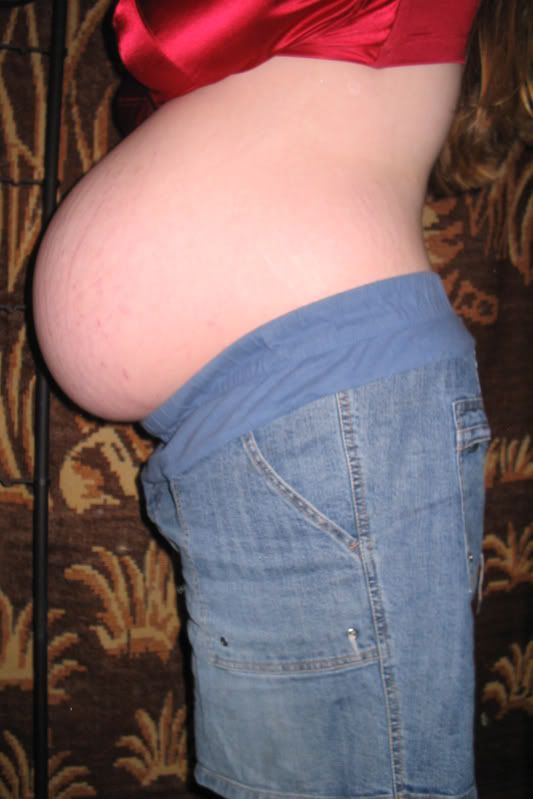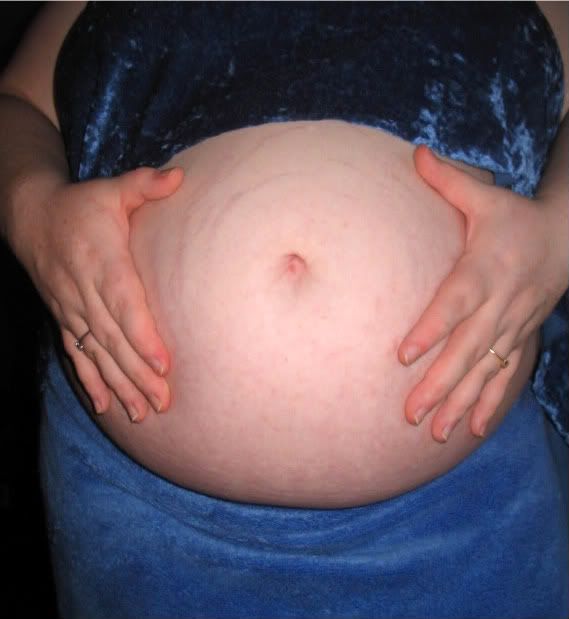
My first daughter was born at 42 weeks, perfectly healthy and in the same state as her sister born at 39 weeks, 6 days. A lot of people asked "Why are they letting you go so long?" I can't tell you how angry that question makes me. It devalues me as a thinking adult--like I'm a child who needs permission to continue a pregnancy. The implication is that I'm incapable of making an intelligent, educated decision (which, according to studies, induction is NOT) and that I should be 'stopped' from continuing a healthy, normal-term pregnancy!
However, while the wording leaves much to be desired (and isn't meant as the insult that it is), I understand their concern. Most people are still only informed of the last major study done on infant outcomes at gestational ages--from 60 years ago. That's right, from the 1950s, when people still had black and white television and weren't aware x-rays caused cancer.
The fact is that we don't live in the 50s anymore and the technology and the times have changed--and so have mortality rates. Women's have gone up with inductions and unnecessary cesareans and so have infants'. But they are still FAR lower than in the 1950s! Especially when you remember that women were advised to eat very little back then so that they would not gain too much weight--after all, they needed to please their husbands above all else!
The concern for later weeks in pregnancy is the placenta. It is an organ unlike any other: it forms to perform one temporary function and is then expelled from the body. In that time, though, it requires the same care you would give any other organ: specialized care and nutrition for its optimal health. Placentas crave protein and most women just don't get enough.
Also, most people seem unaware that 42 weeks is as normal as 40 weeks. 41 weeks is actually more "average" than either of those weeks. And babies born anywhere from 38-42 weeks (spontaneously) have roughly the same outcomes today. You aren't even "overdue" medically until 42+1 days.
The following is an excerpt from Midwifery today:
A Timely Birth
Postdates, by itself, is not associated with poor pregnancy outcome. Extreme postdates or postdates in conjunction with poor fetal growth or developmental abnormalities does show an increased risk of stillbirth. But if growth restriction and birth defects are removed, there is no statistical increase in risk until a pregnancy reaches 42 weeks and no significant risk until past 43 weeks. The primary “evidence” of a sharp rise in stillbirth after 40 weeks—often misquoted as “double at 42 weeks and triple at 43 weeks”—seems to come from one study based on data collected in 1958.(1)
The first question one should ask is whether neonatal mortality statistics from the 1950s should be compared to modern statistics, since labor anesthetics and forceps rates were very different. Early labor monitoring was scanty and prenatal monitoring not yet developed. The McClure-Brown report shows a rise in stillbirth from 10/1000 at 40 weeks to about 18/1000 at 42 weeks. Yes, that is nearly double. But think about those numbers. Even the beginning point is nearly ten times the modern mortality rate. Either modern delivery methods are vastly different or something is wrong with the data collection. This study should be updated by research conducted at least in this century! Modern statistics show an almost flat rate of stillbirth from 40 weeks to 42, with a slight rise at 43 weeks (all numbers being close to 1/1,000).(2)
There is a creeping overreaction in dealing with postdates pregnancies. It is true that the stillbirth and fetal distress rates rise more sharply after 43 weeks, but it is also true that less than ten percent of babies born at 43 weeks suffer from postmaturity syndrome (over 90% show no signs). We should react to this rise by monitoring postdate pregnancies carefully and inducing if problems arise. But the rise in problems at 43 weeks does not imply a similar risk at 42 and 41 weeks. Postmaturity syndrome is a continuum. It becomes more likely as weeks progress past the due date but does not start on the due date. And the risks need to be compared to the risks of interventions. Induction, as already noted, is not risk free. In addition to the risks of prematurity, induced labors have higher rates of cesarean section, uterine rupture, cord prolapse, meconium aspiration, fetal distress, neonatal jaundice, maternal hemorrhage and even the rare but disastrous amniotic fluid embolism.
Large studies have shown that monitoring pregnancy while waiting for spontaneous labor results in fewer cesareans without any rise in the stillbirth rate. One retrospective study of almost 1,800 post-term (past 42 weeks) pregnancies with reliable dates compared this group with a matched group delivering “on time” (between 37 and 41 weeks). The perinatal mortality was similar in both groups (0.56 /1,000 in the post-term and 0.75/1,000 in the on-time group). The rates of meconium, shoulder dystocia and cesarean were almost identical. The rates of fetal distress, instrumental delivery and low Apgar were actually lower in the postdate group than in the on-time group.(3) This is only one of several studies showing postdate pregnancies can be monitored safely until delivery or until indications arise for induction. Even the famous Canadian Multicenter Post-term Pregnancy Trial Group (Hannah) of 1,700 postdates women showed no difference in perinatal outcome among women who were monitored past their due date, as compared with those who were induced at term.(4)
In some studies, post-term births have shown a higher cesarean rate for suspected fetal distress. However, when a group of researchers conducted a case-matched review of nearly 300 postdates pregnancies they concluded that the increased rate of obstetric and neonatal interventions “does not appear to be a result of underlying pathology associated with post-term pregnancy.” They suggest that “a lower threshold for clinical intervention in pregnancies perceived to be ‘at-risk’ may be a significant contributing factor.” In other words, the perceived risk is greater than the actual risk and can become a self-fulfilling prophecy!(5) When monitoring demonstrates that fetal growth, activity and amniotic fluid levels remain within expected norms, the baby can safely wait for spontaneous labor to begin. Spontaneous labor gives the greatest chance for vaginal birth, even though the baby may be slightly larger than if the mother were induced at 40 weeks.
References:
- McClure-Browne, J.C. 1963. Comparison of perinatal mortality rates versus gestational age through the past three decades. Am J Obstet Gynecol 85: 573–82.
- Eden, R.D., et al. 1987. Perinatal characteristics of uncomplicated postdates pregnancies. Obstet Gynecol 69(3 Pt.1): 296–99.
- Weinstein, D., et al. 1996. Expectant management of post-term patients: observations and outcome. J Matern Fetal Med 5(5): 293–97.
- Hannah, M.E., et al. 1992. Induction of labor as compared with serial antenatal monitoring in post-term pregnancy. A randomized controlled trial. The Canadian Multicenter Post-term Pregnancy Trial Group. N Engl J Med 326(24): 1587–92.
- Luckas, M., et al. 1998. Comparison of outcomes in uncomplicated term and post-term pregnancy following spontaneous labor. J Perinat Med 26(6): 475–79.
Excerpted from "A Timely Birth," Midwifery Today, Issue 72
http://www.midwiferytoday.com/enews/enews1220.asp




